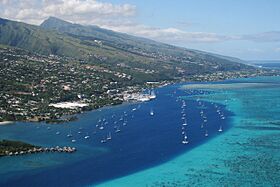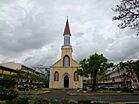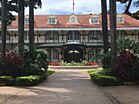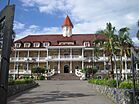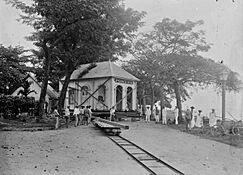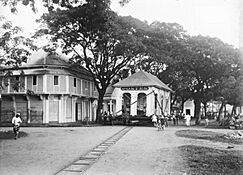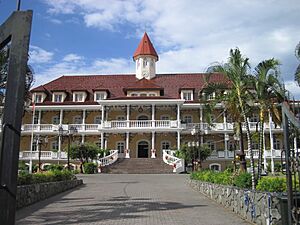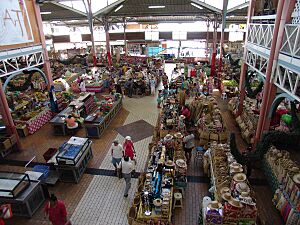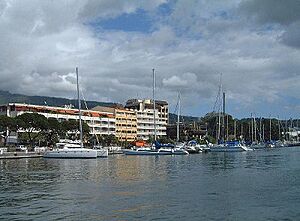Papeete facts for kids
Quick facts for kids
Papeʻetē
|
|
|---|---|
|
Top: Aerial view of Pape'etē; Middle: Cathedral of Notre Dame of Papeʻetē, Presidential palace; Bottom: Pape'etēTown Hall, Bougainville Park
|
|

Location of the commune (in red) within the Windward Islands
|
|
| Country | France |
| Overseas collectivity | French Polynesia |
| Subdivision | Windward Islands |
| Area
1
|
17.4 km2 (6.7 sq mi) |
| • Urban | 299.5 km2 (115.6 sq mi) |
| Population
(2022)
|
26,654 |
| • Density | 1,532/km2 (3,967/sq mi) |
| • Urban | 124,274 |
| • Urban density | 414.94/km2 (1,074.69/sq mi) |
| Time zone | UTC−10:00 |
| INSEE/Postal code |
98735 /98714
|
| Elevation | 0–621 m (0–2,037 ft) |
| 1 French Land Register data, which excludes lakes, ponds, glaciers > 1 km2 (0.386 sq mi or 247 acres) and river estuaries. | |
Papeete (pronounced Pa-peh-eh-teh in Tahitian) is the capital city of French Polynesia. This is a group of islands in the Pacific Ocean that belongs to France. Papeete is located on the island of Tahiti.
It is the main center for government, business, and finance in French Polynesia. It is also a popular spot for tourists and a busy port. The name Papeʻetē means "water from a basket." This name came about because of an old Tahitian custom. The city's original name was Vaiʻetē, which is still known in some areas. In 2022, about 26,654 people lived in Papeete itself. The larger city area, including nearby towns, had about 124,724 people.
Contents
Exploring Papeʻetē's Geography

Papeʻetē is divided into eleven smaller areas called quartiers (wards). These areas include both coastal and inland parts of the city.
|
||||||||||||||||||||||||||||||||||||||||||||||||||||||||||||||||||||||||||||||
Papeʻetē's Tropical Climate
Papeʻetē has a tropical monsoon climate. This means it has a wet season and a dry season. Temperatures and humidity are high all year round.
The dry season is short, only in August and September. The rest of the year is wet, with the most rain in December and January. Even during the dry season, some rain falls. The city gets a good amount of sunshine because most rain comes from quick thunderstorms.
| Climate data for Papeʻetē (1981–2010 averages, extremes 1976−present) | |||||||||||||
|---|---|---|---|---|---|---|---|---|---|---|---|---|---|
| Month | Jan | Feb | Mar | Apr | May | Jun | Jul | Aug | Sep | Oct | Nov | Dec | Year |
| Record high °C (°F) | 36.0 (96.8) |
34.3 (93.7) |
35.3 (95.5) |
35.0 (95.0) |
34.5 (94.1) |
33.8 (92.8) |
33.0 (91.4) |
33.9 (93.0) |
33.9 (93.0) |
33.9 (93.0) |
34.0 (93.2) |
34.3 (93.7) |
36.0 (96.8) |
| Mean daily maximum °C (°F) | 31.2 (88.2) |
31.4 (88.5) |
31.9 (89.4) |
31.8 (89.2) |
31.1 (88.0) |
30.3 (86.5) |
30.0 (86.0) |
30.0 (86.0) |
30.3 (86.5) |
30.5 (86.9) |
30.6 (87.1) |
30.4 (86.7) |
30.8 (87.4) |
| Daily mean °C (°F) | 27.1 (80.8) |
27.2 (81.0) |
27.6 (81.7) |
27.6 (81.7) |
26.8 (80.2) |
25.9 (78.6) |
25.6 (78.1) |
25.5 (77.9) |
25.9 (78.6) |
26.3 (79.3) |
26.6 (79.9) |
26.6 (79.9) |
26.6 (79.9) |
| Mean daily minimum °C (°F) | 23.0 (73.4) |
23.1 (73.6) |
23.4 (74.1) |
23.3 (73.9) |
22.6 (72.7) |
21.6 (70.9) |
21.2 (70.2) |
21.1 (70.0) |
21.6 (70.9) |
22.1 (71.8) |
22.6 (72.7) |
22.9 (73.2) |
22.4 (72.3) |
| Record low °C (°F) | 19.2 (66.6) |
19.2 (66.6) |
20.4 (68.7) |
20.1 (68.2) |
19.5 (67.1) |
16.9 (62.4) |
16.0 (60.8) |
17.0 (62.6) |
17.0 (62.6) |
16.0 (60.8) |
19.0 (66.2) |
19.4 (66.9) |
16.0 (60.8) |
| Average precipitation mm (inches) | 317.5 (12.50) |
277.7 (10.93) |
240.2 (9.46) |
143.1 (5.63) |
149.5 (5.89) |
80.8 (3.18) |
62.7 (2.47) |
66.4 (2.61) |
64.3 (2.53) |
120.9 (4.76) |
155.2 (6.11) |
396.8 (15.62) |
2,075.1 (81.70) |
| Average precipitation days (≥ 1.0 mm) | 14.6 | 13.4 | 11.3 | 9.2 | 8.5 | 6.0 | 5.7 | 5.2 | 5.2 | 7.8 | 9.9 | 15.3 | 112.1 |
| Mean monthly sunshine hours | 215.5 | 199.2 | 226.0 | 230.3 | 228.6 | 220.0 | 235.2 | 251.1 | 241.6 | 232.1 | 208.7 | 196.6 | 2,684.9 |
| Source 1: Meteociel | |||||||||||||
| Source 2: NOAA (sun 1961–1990) | |||||||||||||
Papeʻetē's Past: A Brief History
In 1902, the post office in Papeʻetē needed to be moved. Instead of tearing it down, workers lifted the building and moved it whole. They used a special Decauville railway system for this big task.
Before that, a light railway was used to build a large water tower. This tower helped supply drinking water to Papeʻetē. During World War I, German ships attacked Papeʻetē. This caused damage and some people lost their lives.
The city grew a lot when France decided to move its nuclear testing site. The new site was on islands about 1,500 km (930 mi) east of Tahiti. This also led to the building of the Faa'a International Airport. This is the only international airport in French Polynesia, located near Papeʻetē.
In 1983, The Church of Jesus Christ of Latter-day Saints built the Papeete Tahiti Temple here. They chose Papeʻetē because many of their members live in the area.
Getting Around Papeʻetē
The streets in the city center are often very busy. Traffic can be a challenge because the roads are narrow. The main highway in Tahiti starts near the city center. It is called Pōmare Boulevard, named after the Tahitian Royal Family.
For air travel, people use the Faa'a International Airport. You can take flights to other islands with Air Tahiti. International flights are offered by Air Tahiti Nui, Air France, and other airlines. If you want to travel by sea, there are ferry services. You can go to Moorea or take a cruise to Bora Bora.
Papeʻetē's Population
In 2022, the main city area of Papeʻetē had about 124,724 people. About 26,654 of them lived in Papeʻetē itself. The larger urban area includes six different towns. These towns are:
- Māhina
- Arue
- Pīra'e
- Papeʻetē (the capital and historically the largest town)
- Faʻaʻā (which became the largest town in 1988)
- Punaʻauia
Languages Spoken in Papeʻetē
Most people aged 15 and older in Papeʻetē speak French. In 2017, about 98.4% of people could speak French. Also, 83.9% said French was the language they spoke most at home.
About 13.5% of people spoke Tahitian most often at home. Some people also speak other Polynesian languages or Chinese dialects.
Fun Things to See and Do in Papeʻetē
Papeʻetē has many interesting places to visit:
- The waterfront esplanade is a lovely place to walk.
- Bougainville Park is named after Louis Antoine de Bougainville. He was the first French explorer to sail around the world.
- The Cathedral of Notre Dame of Papeʻetē is a beautiful church.
- The Territorial Assembly building is where the Polynesian government meets. It was once the site of Queen Pōmare IV's royal palace.
- The Presidential Palace is another important government building.
- Papeʻetē Market is a lively place to find local goods.
- The Papeʻetē Tahiti Temple is a special building for The Church of Jesus Christ of Latter-day Saints.
- The Monument to Pouvanaʻa a Oopa honors a local hero and politician.
- The Mairie is the town hall.
Papeʻetē's Economy

Papeʻetē is a major economic center. Many businesses and services are located here. For example, Air Tahiti Nui, a big airline, has its main office in Papeʻetē.
Education in Papeʻetē
The Lycée Paul-Gauguin is a high school located in the city.
Famous People from Papeʻetē
- Chantal Galenon, a politician and activist for women's rights.
- Unutea Hirshon, a politician and activist.
- Andy Tupaia, a musician.
Images for kids
See also
 In Spanish: Papeete para niños
In Spanish: Papeete para niños


